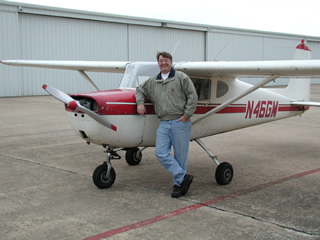What in the world am I thinking?!
I am building a custom aircraft also known as a sportplane, an amateur-built airplane, or simply a homebuilt. Yes, it is a real airplane with real wings and an enclosed cockpit. It is not an ultralight or a powered parachute. It is a real, live, solid airplane with a real aircraft engine. Why am I doing this? Well, here are some of my excuses. I reserve the right to add more.
 When I started my flight training I was initially taken by surprise by the plane I was to be flying in. It was a 1959 Cessna 150 with many, many hours of service as a primary trainer. My initial reaction was similar to the Luke Skywalker line: "What a piece of Junk!" When I started my flight training I was initially taken by surprise by the plane I was to be flying in. It was a 1959 Cessna 150 with many, many hours of service as a primary trainer. My initial reaction was similar to the Luke Skywalker line: "What a piece of Junk!"
I soon realized that the old adage "you get what you pay for" is certainly true in aviation. The trainers most of us can afford are certainly not the nicest planes in the sky, and many of these suffer a lot of abuse. I got used to flying this old crate around, and amazingly it held up to all of my hard landings.
Soon after I received my private pilot's certificate, I begain to consider the option of buying something similar to what I had trained in. After all, it is probably one of the cheapest ways to get into the air. So, I started looking around at ads, and quickly noticed that although a Cessna 150 can be purchased for as little as $15,000, to get one that was not a total wreck can add up to $25,000 or more. Add on to that the cost of operation and maintenance and the inevitable modernization of an aged airplane, and it can get quite expensive. Every year you must send the plane to a mechanic for an "annual" inspection. These exercises can cost $1000 or more, and in most circumstances the repairs cannot be performed by the owner. In addition, if the engine is "run out," you can easily double the cost of the plane by installing a new engine.
The other drawback of most of the planes you can buy for under $30,000 is that they aren't all that useful. Once I flew a cross country in the 150 where on the return trip I was flying into a 30kt headwind. It sure was discouraging to see the cars on the highway going faster than me. I wanted a plane that would get up and go. I wanted to have a valid reason for owning an airplane. I wanted to be able to fly the 300 mile trip to visit family and friends, and do it in less than half the time it takes by car.
So naturally I was open to other options. I had always been intrigued by the possibility of building a plane, but I told myself not to even consider it until I finished my pilot's license. I have a friend locally who has built a Sonex. His progress convinced me that it was possible to build a plane in my garage, so when I passed my private pilot checkride, I started looking at kits.
My first concern about building a plane was the complexity of the process. I don't like starting projects that I cannot finish, and I know of many kitplanes that sit unfinished in garages around the country.
The second concern was about performance. I did not want to build a plane that was as slow and deliberate as the Cessnas I have been flying. I wanted something that would go at least twice as fast as my car on the interstate.
Third, and possibly most importantly, was the cost factor. I don't have a lot of money to spend on flying. I had already calculated the costs of owning versus renting, and was discouraged by the ongoing costs associated with maintaining a 'certified' airplane. I decided that unless there was a way for me to do some or most of the maintenance, that ownership would simply be out of my price range. I know that flying is a costly pastime. I also know that there are always ways to do things more efficiently.
Next: Why Van's Aircraft?
|

